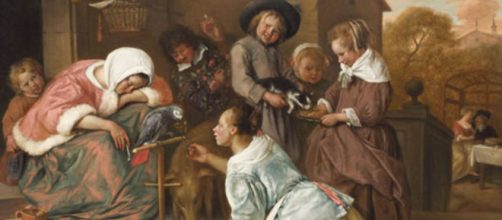Sin. Beside the Biblical one about you know who ate you know what, the ancient Greeks counted seven sins, tagging them “deadly”: pride, greed, lust, envy, gluttony, wrath and sloth. UK’s National Gallery is showing our trespasses in artwork until October 2023.
Exhibit examples extend over a wide range of images, not only by Old Masters, and modernists like Andy Warhol, but also by contemporaries like Tracey Emin. And as mixed a bag as this show is, and despite the show title “Sin,” not all the works describe that.
What’s wrong with this picture?
Emin’s example is a neon sign simply saying, “It was just a kiss.” Warhol also offered signage: “Repent.
Sin No More.” See? No sign of evildoing. Ditto, Diego Velázquez’s painting “The Immaculate Conception.” A picture of the Virgin Mary believed to be born without sin seems an odd choice for a show called “Sin.”
Exhibit curator Joost Joustra acknowledged the oddity of including Velázquez’s painting. “You don’t necessarily associate it with sin, but it is very much about sin.” Really? The Virgin Mary? “In its broadest sense, sin has been on artists’ minds almost continuously,” he said.
Certainly, sin was “almost continuously” on the mind of Jan Steen, the leading genre painter of the Dutch Golden Age. As far as he was concerned, when it comes to sin, women are to blame for the wrongdoing of others.
You can see this in his painting “The Effects of Intemperance,” now on display in the “Sin” show.
As noted in the 1996 bio “Jan Steen: Painter and Storyteller,” Steen owned a tavern. Surely he knew the effects of drinking too much. And just as surely, the drunkenness that he witnessed couldn’t all have been female. Yet, in “The Effect of Intemperance,” he focuses not only on an inebriated woman but also piles on by portraying her as a wife and mother.
So, besides the drunken woman sleeping it off, you see a small boy, presumably her son, taking advantage of her oblivious state by attempting to steal from her purse, and her husband carrying on with the family maid.
This painting blaming a woman was not a one-off. Steen found similar fault with another woman in his painting, “Beware of Luxury.” What you see is a household gone wild.
While a female conks out from drink, her family can be seen raising hell. Her husband dallies with another woman and a small boy tries smoking a pipe.
To make certain you get the point, Steen added a pig to the scene, sauntering through the house.
Who’s to blame?
Clearly, Steen believes that the husband has no responsibility for his actions or that of the boy, presumably his son. All misbehaving falls on the woman. Isn’t that like saying that we’d all still be in the Garden of Eden if only Eve didn’t offer the apple to Adam?
Or are women the only ones held to account?


